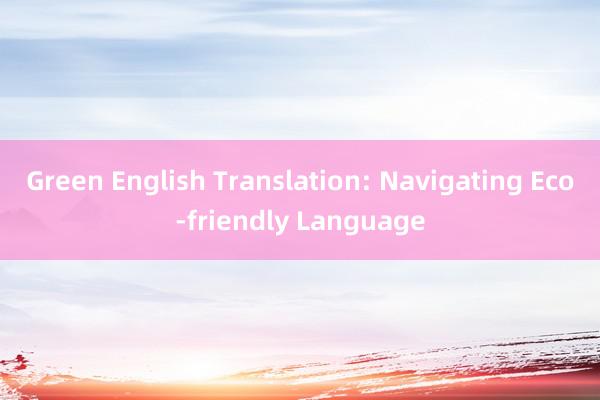时间:2024-09-09 09:23

### Green English Translation: Navigating Eco-friendly Language
In today's world, the language we use is not just a tool for communication; it is also a powerful reflection of our values and actions towards the environment. As awareness about climate change and environmental degradation grows, so does the importance of using eco-friendly language. This article aims to guide you through the essentials of eco-friendly language in English, helping you express your commitment to sustainability effectively.
#### 1. **Biodiversity and Conservation**
- **Diversity**: Use "diversity" instead of "variety" when referring to species or ecosystems, as "diversity" emphasizes the unique and complex interplay of life forms.
- **Conservation**: Prefer "conservation" over "protection" or "preservation." While all terms refer to maintaining ecological balance, "conservation" specifically involves sustainable management practices that aim to protect resources for future generations.
#### 2. **Sustainable Practices**
- **Reduce, Reuse,望江百耀晒图机有限公司 Recycle**: These three Rs are fundamental to eco-friendly language. Encourage them by using these phrases in discussions about waste management.
- **Sustainable**: This term is crucial for describing products, IT技术学习 practices, 首页-盛 卓卡咖啡有限公司 or lifestyles that aim to minimize environmental impact while meeting current needs without compromising future generations.
#### 3. **Energy and Resources**
- **Renewable Energy**: Always opt for "renewable energy" over "green energy" or "clean energy." Renewable energy sources (like solar,天长市怡和玩具进出口有限公司 wind, and hydroelectric power) are sustainable because they can be replenished naturally.
- **Efficiency**: Emphasize efficiency over "conservation" when discussing energy use. For example, "energy-efficient appliances" rather than "energy-conserving appliances."
#### 4. **Eco-friendly Products**
- **Biodegradable**: Use "biodegradable" instead of "degradable" to highlight products that break down naturally, reducing pollution.
- **Eco-friendly**: This term encapsulates products designed with minimal environmental impact, making it a cornerstone in eco-friendly language.
#### 5. **Environmental Policies and Actions**
- **Green Initiatives**: Highlight initiatives that promote environmental protection and sustainability. Use "green" to emphasize these efforts, such as "green policies" or "green campaigns."
- **Carbon Footprint**: Discuss the environmental impact of actions or products by mentioning their carbon footprint. This term encourages awareness and action towards reducing emissions.
#### 6. **Language Usage Tips**
- **Avoid Jargon**: While technical terms like "carbon neutrality" or "zero waste" are important, ensure they are explained clearly for broader audience understanding.
- **Inclusive Language**: Use inclusive language that acknowledges different perspectives and actions towards sustainability. Avoid biases and stereotypes in your choice of words.
By integrating these tips into everyday communication, you can contribute to a more sustainable discourse. Remember, eco-friendly language is not just about the words you choose but also about the values and actions they represent. Through mindful language use天长市怡和玩具进出口有限公司, we can foster a collective commitment to environmental stewardship.